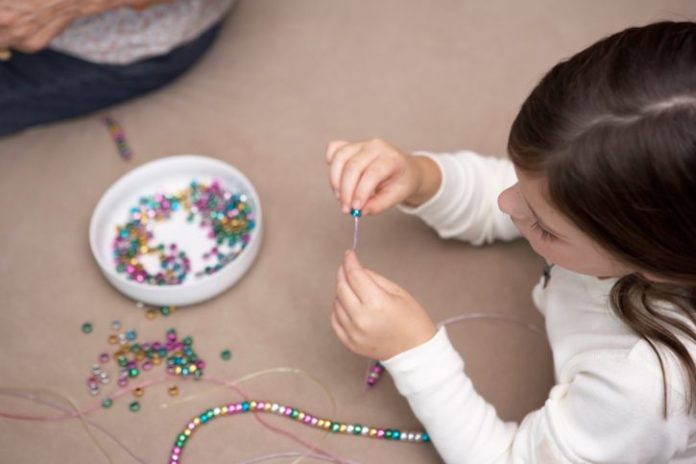At St. Jude Children’s Research Hospital, patients use beads to mark treatment milestones, from losing their hair to completing chemotherapy, in a program other hospitals could tailor to meet the needs of their patients
When Kayla Dehnert tells friends and family in Northern California about life as a St. Jude Children’s Research Hospital patient, she pulls out a string of beads taller than she is.
“This is a learning-to-take medicine bead,” Kayla explains, fingering the bumps of a bluish-lavender bead and working her way down the long strand. “This yellow bead is the change-the-bandage bead, and the tiger bead is the losing-your-hair bead.”
Kayla, 8, of Novato, Calif., is one of hundreds of St. Jude patients who have participated in the hospital’s Legacy Bead program since its launch in 2009. The program offers patients and their families a tangible way to illustrate their journeys using 55 glass beads as unique as the children who collect them. Patients receive vivid green cylindrical beads for blood transfusions; sapphire round beads for lumbar punctures; tear-drop beads in assorted colors for homesickness; and blue, triangle-shaped beads for clinic visits. Other beads mark triumphs such as the completion of radiation or chemotherapy or challenges ranging from cancer’s return to the death of a friend.
“The beads are like a badge of honor. The string helps put into perspective what we’ve been through. Each bead represents an important part of her journey,” said Denny Dehnert, Kayla’s father. “They’ve made some harder days more bearable.”
The Legacy Bead program is one of several methods, including journaling and memory boxes, which the St. Jude Child Life Program offers to patients and families to chronicle their journeys and help build legacies. The approach was highlighted in work published recently in the Journal of Pediatric Nursing.
“Some patients use the beads to express how they are feeling about their treatment journeys and a tangible way to share with siblings or friends what happened today or what treatment involves,” explained Shawna Grissom, Child Life director and the study’s corresponding author. “Other patients will have the beads as a memory of what happened during this step in their journey of life and some patients will leave the string as a memory for their families to have and pass on.”
St. Jude designed its own bead program because existing options did not specifically address the challenges facing many of the hospital’s young patients. “We hope other institutions will adapt our program to the specific needs of their patients with chronic illnesses or life-threatening diseases,” Grissom said. “This approach could be employed for adults as well as children. Family members could use the beads to talk to children about adults who do not survive their illness.”
Because patients often collect the beads throughout the hospital, Grissom said the program also gives staff another opportunity to talk to patients about their care, including why needle sticks are necessary or why a patient might need another MRI. “The program gives patients and staff a chance to celebrate accomplishments and reinforces the staff’s role in every child’s journey,” Grissom said.
Kayla’s bead collection started December 6, 2011, the day she arrived at St. Jude for treatment of the brain tumor medulloblastoma. Her string begins with beads that spell out her name and a bead with the hospital’s logo. She added a piece of dry penne pasta to her strand, which stretches more than 5 feet, when she visited her classroom back home. “Her class was working on a project that included the pasta. She included a piece on her strand to represent sharing her experiences at St. Jude with her class,” Denny Dehnert said.
The Legacy Bead program was so popular the hospital added a similar program for patient siblings. Brothers and sisters earn beads for contributions ranging from serving as bone marrow donors to traveling to St. Jude with their families. “Siblings play such a huge role in supporting the family and patient throughout treatment. We want to make sure they are not forgotten,” Grissom said.
The bead Kayla is most anxious to get is silver and barrel-shaped, which marks the end of chemotherapy. After that, Annie Dehnert, Kayla’s mother, would like to showcase the strand in a shadow box, but Kayla is holding out for a necklace.











